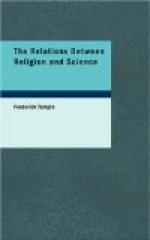It will be matter of consideration in a future Lecture how our knowledge of the Eternal Law of the holy, the just, the good, and the right, is thus purified in the individual and in the race. At present it will be enough to have indicated the general principle of what may be called the evolution of the knowledge of morals.
But I now go on from the Moral Law as a duty to the Moral Law as a faith. For the inner voice is not content with commanding a course of conduct and requiring obedience of that kind. This is its first utterance, and the man who hears and obeys unquestionably has within him the true seed of all religion. But though the first utterance it is not the last. For the same voice goes on to require us to believe that this Moral Law which claims obedience from us, equally claims obedience from all else that exists. It is absolutely supreme or it is nothing.
Its title to our obedience is its supremacy, and it has no other title. If it depended on promises of reward or threats of punishment addressed to us, it might be considered as a law for us, but could be no law for others. It would in that case, indeed, be a mere physical law. Things are so arranged for you, and as far as you know for you only, that terrible pain will come to you if you disobey, and wonderful pleasure if you obey. Such a law as that might proceed from a tyrant possessed of absolute power over US and the things that concern US, and might be either good or bad as should happen. But such a law would not be able to claim our reverence. Nay, rather, as is the case with all merely physical laws, it might be our duty to disobey it. In claiming our reverence as well as our obedience, in making its sanction consist in nothing but the fact of its own inherent majesty, the Moral Law calls on us to believe in its supremacy. It claims that it is the last and highest of all laws. The world before us is governed by uniformities as far as we can judge, but above and behind all these uniformities is the supreme uniformity, the eternal law of right and wrong, and all other laws, of whatever kind, must ultimately be harmonised by it alone. The Moral Law would be itself unjust if it bade us disregard all physical laws, and yet was itself subordinate to those physical laws. It has a right to require us to disregard everything but itself, if it be itself supreme; if not, its claim would be unjust. We see here in things around us no demonstrative proof that it is supreme, except what may be summed up in saying that there is a power that makes for righteousness. Enlightened by the Moral Law we can see strongly marked traces of its working in all things. The beauty, the order, the general tendency of all creation accords with the supremacy of the Moral Law over it all. But that is by no means all. We see, and we know that we see, but an infinitesimal fraction of the whole. And the result of this partial vision is that, while there is much in things around us which




